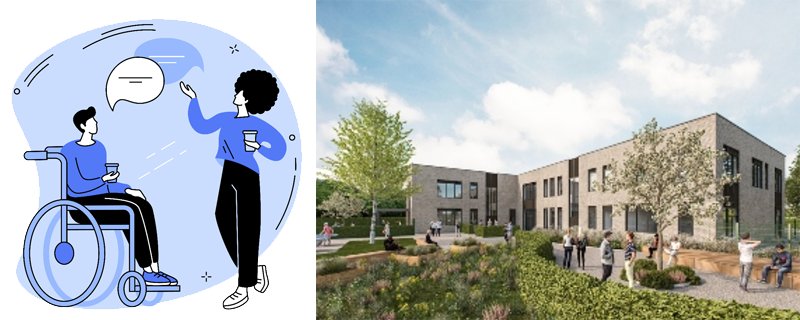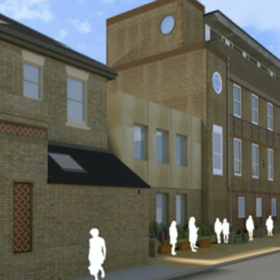Building inclusive schools
Image: Meadowbrook College
By Claire Mantle school sector lead at ADP Architecture
Latest Government figures show that close to 1.5 million pupils in England have special educational needs (SEN). That’s 12.6% of pupils who now need some kind of SEN support, most commonly relating to Autistic Spectrum Disorder (ASD) and specifically to speech, language and communication. It’s a sizable fraction that speaks to our growing understanding of diverse learning needs.
The Government recently revealed its green paper for educational reform for young people with special educational needs and disabilities (SEND), which sets out proposals to offer children the right support in a timely manner, levelling the playing field. The review and proposals are very welcome, but only represent the first step in providing a robust and inclusive education system, and may take many years to come into effect.
ADP’s experience has shown us the essential role of architecture and design in making schools more accessible, and in providing environments that nurture all pupils as individuals – an agenda all schools will need to embrace moving forward.
Through our work, we have learned, for example, how important routines are to young people with ASD. Dealing with the unexpected, planning ahead, shifting between tasks, and controlling impulsive behaviour can all be causes of anxiety for these students. Equally difficult can be navigating confusing building layouts and learning within a cluttered classroom space. In addition, many young people with ASD have difficulty processing sensory information, creating barriers to communication. As a result, unstructured times such as lunch-breaks can be especially challenging.
As architects, one of the simplest ways we’ve found to help reduce these daily frustrations, and to help manage challenging behaviour, is by designing and adapting buildings so that they build on and develop children’s confidence and independence.
Designing spaces through our senses
A key consideration here is proxemics – the science of understanding personal space. Pupils with ASD generally need more physical space surrounding them, so we aim for wide corridors, generous room proportions, and multiple visible exit points. Designing within a single storey helps children navigate a building independently, though this is obviously not always practical. Simple landmarks aid independent navigation, as does signage which is simple, clear and relevant.
The transition from drop-off to desk should be free from distractions and obstructions. Materials, patterns and colour can have a huge impact on someone’s journey to and from the classroom, especially when crossing thresholds or turning corners: something as simple as speckled vinyl can be unsettling and disruptive for pupils with ASD.
To make inside spaces comfortable, visuals should not be overstimulating – less is more! It’s important to avoid direct sunlight into a space or reflections that could cause distraction. Orienting a new building to avoid solar glare can also help reduce overheating; in learning spaces with large windows, you can use films on windows to allow the light in while avoiding visual distraction.
Natural, textured materials and finishes also help here. Pay careful attention to colour: earth tones such as greens can induce calm and blue aids concentration, but reds and yellows can be overstimulating.
The internal environment can be a challenge for people with neurodiversity if acoustics have not been considered correctly. Deadening reverberations can be vital, and as architects we specify products which are particularly good at absorbing sound when designing a classroom. It’s also worth considering the noise made by equipment: buzzing lights, for instance, can be distracting for people with ASD.
There will be times when pupils will want to retreat and have time on their own, so it may be appropriate to have ‘calm’ rooms for respite, and to incorporate quiet seating areas off corridors. Looking beyond the student community, it’s important to consider support areas for parents, and access to pupil therapy suites if possible.
All students – not only those with ASD – should feel a sense of belonging to their school. To achieve this, we often use co-design with students. Finally, it’s impossible to understate the importance of nature. Outdoor spaces relieve stress and anxiety, help develop social skills, and motivate learning – particularly for those with SEN.
While the Government’s green paper is a positive long-term framework for change, many of the design considerations above can be implemented with almost immediate effect. They demonstrate the importance of knowledge-sharing, between local government, schools, architects, and other specialists, in helping to create learning environments that support the education, wellbeing and everyday lives of every individual child.
Source: Local Government




Leave a Reply
Want to join the discussion?Feel free to contribute!